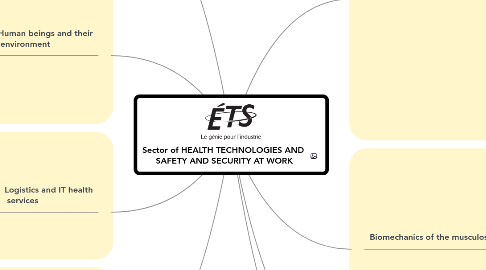
1. Analysis and diagnostics
1.1. Analysis of physiological signals
1.1.1. Muscular contractions
1.1.2. Electroencephalogram
1.1.3. haptic interfaces
1.1.4. 1D and 2D biomedical signals
1.2. Medical equipment for diagnostic and analysis
1.2.1. Tools for decision support
1.3. Monitoring of therapeutic effects
1.4. Technology assessment
2. Medical and surgical devices
2.1. 3D printing
2.2. Audit & Standards (ISO-13485)
2.3. Bioelectronics
2.3.1. Biosensors & Bio-MEMS
2.3.2. Biomembranes, bioassays
2.3.3. Energy gleaning
2.4. Computer-assisted surgical procedures
2.5. Finite element method (FEM)
2.6. Materials and Alloys
2.6.1. Biocompatibility
2.6.2. Biomaterials
2.6.3. Characterization of surfaces
2.6.4. Composite
2.6.5. Nanostructured
2.6.6. Polymer
2.6.7. Porous metals
2.6.8. Shape memory
2.6.9. Superelastic
2.6.10. Surface modification
2.7. Medical robotics
2.7.1. Touch sensors
2.7.2. Controller
2.7.3. Exoskeleton
2.7.4. Advanced IT tools
2.7.5. Smart prosthetic
2.8. Prosthetic & orthotic
2.8.1. Auditory
2.8.2. Bone
2.8.3. Vascular
2.9. Sterilization
2.10. Surgical instruments
2.11. Wheelchair
2.11.1. Control & Propulsion
3. Biomechanics of the musculoskeletal system
3.1. Biomechanical modeling
3.2. Biometrology
3.3. Cartilage / Osteoarthritis
3.4. improvement of the biomechanics
3.5. Motion analysis in 2D and 3D
3.6. Traumatology
4. Researchers and departments involved
4.1. Departments
4.1.1. Department of Automated Production
4.1.2. Department of Mechanical
4.1.3. Department of Electrical
4.1.4. Department of Software and IT
4.2. Researchers
4.2.1. Number of researchers "Core": 17 (researchers who have this area as a central research theme)
4.2.2. Number of researchers "No Core": 17 (researchers who participate in research projects may be related to this topic)
5. Chairs and research units
5.1. Research chairs
5.1.1. Canada Research Chair in Biomaterial and Endovascular Implants
5.1.2. Canada Research Chair in Precision Robotics
5.1.3. Canada Research Chair on 3D Imaging and Biomedical Engineering
5.1.4. ÉTS Research Chair in Vertebral Medullary Traumatology
5.1.5. Research Chair on Protective Materials and Equipment for Occupational Safety and Health
5.1.6. Sonomax-ETS Industrial Research Chair in In-Ear Technologies – CRITIAS
5.2. Accredited research units
5.2.1. ÉREST – Research Team in Occupational Safety and Industrial Risk Analysis
5.2.2. LIO - Laboratory in imaging and orthopedics
5.3. Research units recognized
5.3.1. CoRo – Control and Robotics Laboratory
6. Human beings and their environment
6.1. Communication systems
6.1.1. Brain-computer inteface
6.1.2. Emotion detection
6.1.3. Interfaces for disabled
6.1.4. Speech enhancement in noisy environment
6.1.5. Voice recognition
6.2. Safety and control of industrial risks
6.2.1. Risk Management
6.2.1.1. Standardization
6.2.1.2. Laws
6.2.1.3. Risk assessment
6.2.1.4. Risk integration
6.2.1.5. Expertise SST cases
6.2.2. Safe equipment and workstation design
6.2.2.1. Industrial Audio / Control and reduction
6.2.2.2. Analysis of mechanical structures
6.2.2.3. Lockout / Maintenance
6.2.2.4. Electromechanical control systems
6.2.2.5. Human factors engineering / Physical Ergonomics / Biomechanics
6.2.2.6. Biometrological predictive index
6.2.2.7. Musculoskeletal injuries
6.2.2.8. Security of electronic systems
6.2.2.9. Mechanical vibration / control and reduction
6.2.3. Industrial hygiene
6.2.3.1. Static and dynamic sealing
6.2.3.2. Nanoparticles
6.2.3.3. Fire protection
6.2.3.4. Computer simulation of equipment
6.2.3.5. Thermofluids
6.2.3.6. Ventilation / Air quality
6.2.4. Design of protective equipment
6.2.4.1. Horizontal cables lifeline
6.2.4.2. Advanced communication and hearing protection
6.2.4.3. Protection devices of the vertebral column
6.2.4.4. Tests
6.2.4.5. Gloves and protective clothing
6.2.4.6. Acoustic modeling and simulation
6.2.4.7. Protection against falls
6.3. Software Development & applications in psychology / psychiatry
6.3.1. Alerts buttons
6.3.2. Serious games
6.4. Sound environment
6.4.1. Analysis of noise conditions causing deafness
6.4.2. Control technologies for environmental noise
6.4.3. Mechanisms of generation, transmission and sound radiation
6.4.4. Smart hearing device
6.4.5. Sound quality
7. Logistics and IT health services
7.1. Inventory management and optimization
7.2. IT system
7.2.1. Acquisition of clinical data
7.2.2. Big Data
7.2.3. Electronic patient records
7.3. Services
7.3.1. Optimization of systems and processes
7.3.2. Planning and Scheduling

